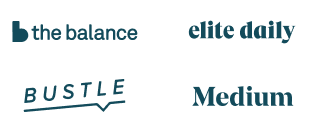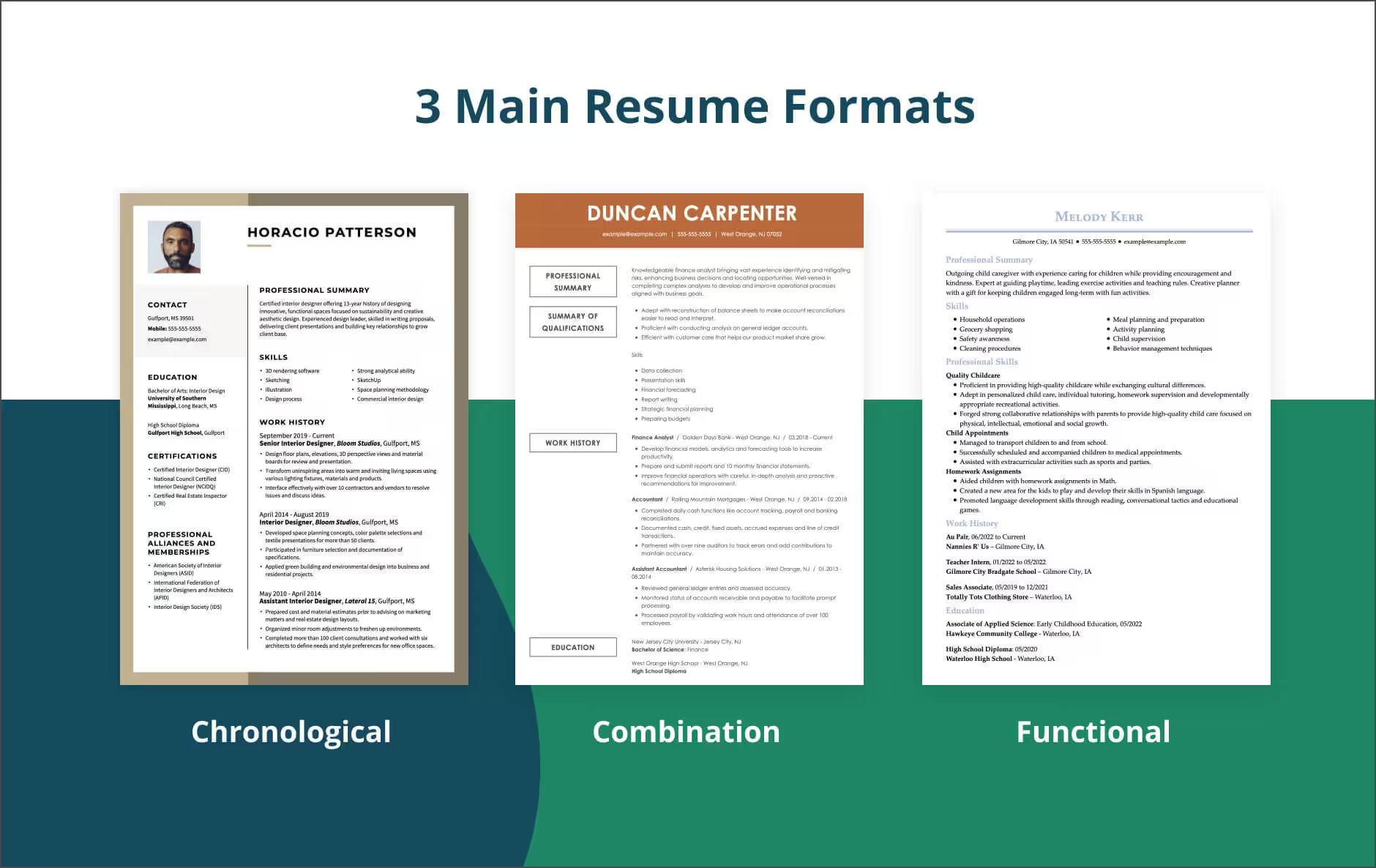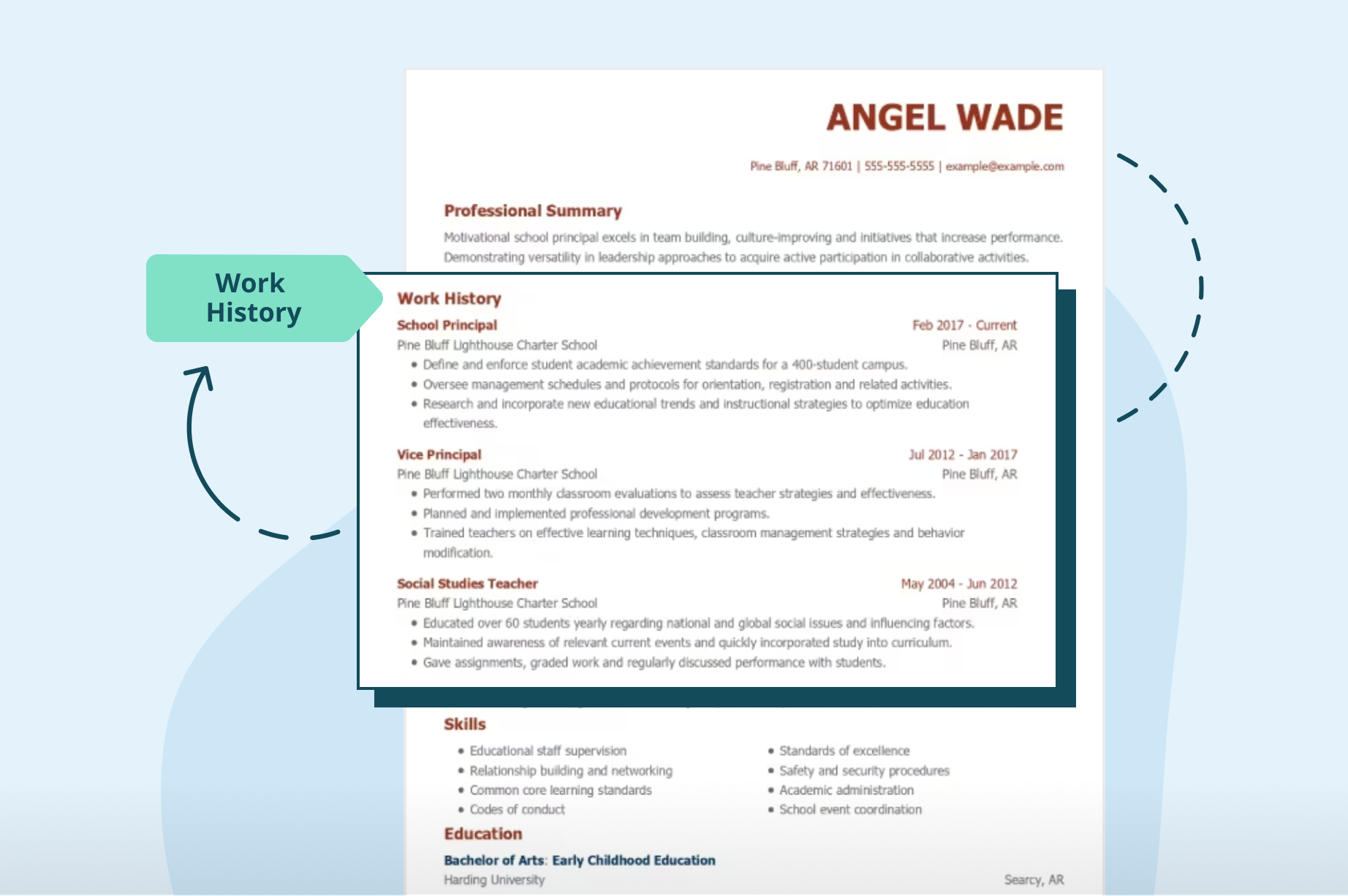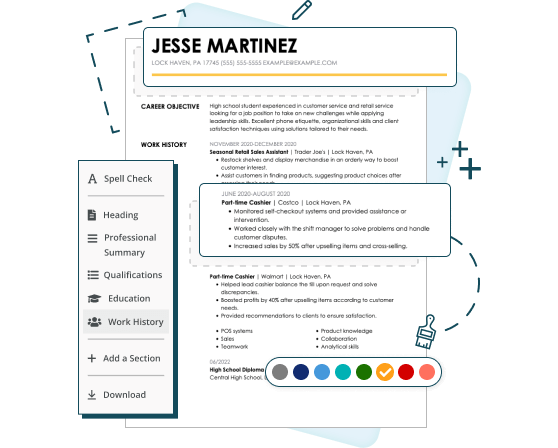- Featured in:


Want a stronger resume? Try our resume templates. Simply edit and download. Plus, you’ll get ready-made content to add with one click using our Resume Builder. Or view our sample resumes made with our professional templates.
What is a Chronological Resume?
Chronological resumes are a timeline-based resume format that organizes your work experience in reverse-chronological order. The work history section of this format lists your most recent job at the top and works backward through your past employment.
A chronological resume helps employers quickly find and track your previous employment, accomplishments, and career progression. The reverse-chronological format lists your job title, previous employer’s name and dates of employment, and detailed descriptions of your previous responsibilities and achievements.
The chronological resume format is best for job seekers with a steady work history and zero work gaps to demonstrate that they are dedicated employees.
How to Format a Chronological Resume?
“Should resumes be in chronological order?” If you’re using a reverse-chronological resume, absolutely! Your resume must include the following sections:

1Contact information:
This section includes your name, phone number, employer-friendly email address and a link to your LinkedIn or other professional portfolio.
2Resume summary:
The summary statement or resume objective is a quick marketing pitch that persuades hiring managers to spend more than seven seconds skimming your resume.
3Work experience:
This chronological summary of your previous jobs uses most of your resume to weave a 10-year outline of your qualifications. Add three to four bullets to each job title to describe yourself.
4Skills:
Add a simple six-to-eight bullet point list of job-relevant skills. Avoid repeating skills previously mentioned in your summary or work history sections to make the most of your resume.
5Education:
Your academic history and professional certifications sit at the bottom of your resume and add legitimacy to your previous accomplishments.
When to Use a Reverse-Chronological Resume
Use a chronological format if:
- You have 10+ years of experience.
- You want to showcase your career arc.
- You don’t have big gaps between jobs.
- You have held a senior-level position.
Don’t use a chronological resume:
- If you spent less than a year with one or more jobs.
- You have frequent gaps between jobs.
- You have less than nine years of experience.
- If you recently graduated.
- If you had to take a recent work break for personal or academic reasons.
Try a different format
If you don’t meet the criteria for writing a chronological resume, try using a different resume format that highlights your employment strengths and downplays potential red flags.
Use a functional resume, or skills-based resume, to highlight your career accomplishments related to job-related skills if you’re returning to the workforce, spent less than a year at a previous job, have frequent work gaps, or rely on freelance gigs.
If you have between three and nine years of experience, use a combination resume. This format combines the best chronological and functional resumes to boost your work history and skills.
Visit our helpful resume layout article to help you correctly format your resume document.

How to Write a Chronological Resume
A chronological resume will always follow this section structure. Read on to find helpful writing tips and effective examples of chronological resumes for each section.
1. Add your contact information
Regardless of which resume format works best for you, every resume should have the following contact information at the top of your resume.
Sample of a contact information section:
Josie Apple, RN, BSN
Boston, MA
555-555-5555
josephine.apple@email.com
2. Persuade with a resume summary
A resume introduction can take the shape of a summary statement or resume objective and pitch two or three of your most relevant skills, certifications or accomplishments to convince hiring managers to dedicate more time to your resume. Let’s see how a skilled registered nurse uses their resume summary to persuade potential employers to read the rest of their chronological resume carefully.
Example of a chronological resume summary statement:
Professional summary:
Dedicated and highly experienced Registered Nurse with a 12-year track record of excellence in emergency room procedures and trauma triage. Passionate about making a difference in underserved communities by working exclusively for hospitals in low-income neighborhoods. Possesses comprehensive knowledge, strong leadership, and a compassionate care approach to contribute to positive patient outcomes. I am committed to providing high-quality healthcare to marginalized populations.
3. Format your work history section
Remember to start with your most recent position and work back through your career. When describing your achievements, grab the recruiter’s attention by providing quantifiable metrics. This adds credibility to your resume by providing a more concrete way to understand your capabilities as an employee.
Example of a chronological resume work history section:
Professional experience:
Emergency Room Nurse | Massachusetts General Hospital
Boston, MA | December 2019 – Current
- Lead the emergency room team, overseeing patient care, triage and assessments.
- Administer critical medications, monitor vital signs and provide life-saving interventions.
- Collaborate with multidisciplinary teams to develop comprehensive care plans.
- Conduct patient education and ensure a smooth transition to the next level of care.
- Mentor and train junior nurses, improving departmental efficiency.
Emergency Room Nurse | Tufts Medical Center
Boston, MA | April 2012 – November 2019
- Worked in a fast-paced, high-stress environment, managing trauma patients effectively.
- Administered advanced life support procedures, including intubation and defibrillation.
- Assisted in the development and implementation of updated emergency protocols.
- Received recognition for maintaining patient satisfaction scores above the national average.
4. Pick resume skills
List a mix of six to eight soft skills and hard skills that best describe your work approach. Then, align these skills to those listed in the job description. Your skills section may then be presented on your resume in bullets or listed as a summary of your qualifications.
Sample of a chronological resume skills section:
Professional skills:
- Emergency room procedures
- Trauma care
- Patient assessment and triage
- Medication administration
- Team leadership
- Patient education
- Electronic Health Records (EHR)
- Multidisciplinary collaboration
5. Finish with a detailed education section
Example of an education section:
Degree:
Bachelor of Science in Nursing | Tufts University
Boston, MA | Date of GraduationMay 2009
Certifications:
- Registered Nurse (RN) License, Massachusetts
- Advanced Cardiac Life Support (ACLS) Certification
- Pediatric Advanced Life Support (PALS) Certification
- Basic Life Support (BLS) Certification
6. Additional writing tips
Visit our detailed resume writing guide to learn more about how to tailor your resume to each job application, but keep the following quick tips in mind.
- Prepare: List your job history in reverse-chronological order before writing your resume. You should also list career accomplishments and the skills you used to achieve them. Considering what you want to feature will make it easier to put it all together!
- Identify resume keywords: Read the job description carefully to identify keywords and phrases the employer wants. You should tailor your resume to each job description if applying for different positions. It will better resonate with employers!
9 Samples of Chronological Resumes
Actor
A skills-based format like the functional resume may be best for actors, but this actor uses a timeline-based approach to highlight their steady employment.
Administrative Assistant
This example of a chronological resume highlights the career growth of this administrative assistant, prepping them for an executive interview.
Copywriter
This copywriter uses the chronological resume to highlight their 12 years of experience, consistent promotions and growth of responsibilities.
Medical Assistant
This medical assistant uses the chronological format to highlight their years of training and development.
Software Engineer
A software engineer with over a decade of experience should use a chronological resume to highlight the growth of projects and responsibilities.
Teacher
A teacher with years of experience should use the chronological summary to highlight the growth of their responsibilities and student development.
Accountant
An accountant should use a chronological order to highlight the increase of client accounts or streamlined procedures that helped minimize accounting errors.
Project Manager
A project manager should use this timeline format to highlight the growth of their project responsibilities and tie clear accomplishments to specific projects.
Human Resources Manager
This HR professional should use a chronological resume to highlight their steady promotions and career progression to apply for promotions.
Free Chronological Resume Template
Use our previous advice, examples and this free chronological resume template to write a professional resume.
Free chronological resume template:
[Your Name]
[Your Phone Number]
[Your Email Address]
[City, State]
Professional Summary:
[Customize: Share three career skills, accomplishments or previous projects that bring potential value to the open role.]
Professional Experience:
[Job Title] | [Company Name]
[City, State] | [Start Date] – [End Date]
- [Bullet 1: Describe your key responsibilities and achievements in this role.]
- [Bullet 2: Describe your key responsibilities and achievements in this role.]
- [Bullet 3: Describe your key responsibilities and achievements in this role.]
[Job Title] | [Company Name]
[City, State] | [Start Date] – [End Date]
- [Bullet 4: Describe your key responsibilities and achievements in this role.]
- [Bullet 5: Describe your key responsibilities and achievements in this role.]
- [Bullet 6: Describe your key responsibilities and achievements in this role.]
Education:
Degrees
[Degree Earned], [Major]
[University/College Name]
[City, State]
[Graduation Date]
Certifications:
[Customize: List any relevant licenses and certifications]
Skills:
- [Skill 1]
- [Skill 2]
- [Skill 3]
- [Skill 4]
- [Skill 5]
- [Skill 6]
- [Optional Skill 7]
- [Optional Skill 8]
Chronological Resume FAQ
What is the difference between chronological and functional resumes?
The main difference between chronological and functional resumes is their format. A chronological resume follows a strict, five-section layout and relies on a timeline to emphasize a candidate’s career progression, making it ideal for those with a strong work history.
A functional resume is highly customizable, can range from five to nine sections, and focuses on job-relevant skills rather than your previous dates of employment. Use functional resumes if you’re a career changer or have employment gaps.
What’s similar between chronological, functional, combination and plain text resumes?
Although the placement and amount of information provided in the work history and skills section are different, these four resume formats share more similarities.
- Contact information: All resume formats include the candidate’s name, address, phone number and email.
- Summary or objective: Each format typically features a summary or objective statement to introduce the job seeker, depending on their experience level and related career paths.
- Education: All four formats include a section listing educational qualifications, such as degrees, institutions and graduation dates.
What is the chronological order on resumes?
Chronological order resumes start with your most recent job and work backward through your last 10 years. You can start your resume with either a current job or a job you held in the previous month or two.
Pro tip: If it’s been more than two months since your last job, use a functional resume to highlight your transferable skills and downplay this work experience.
What is the drawback of chronological resumes?
Although the reverse-chronological resumes are the most familiar format to hiring managers and recruiters, they’re best suited for candidates with over 10 years of non-stop experience in their chosen field. This format can hurt your job opportunities if you don’t meet that criteria. Avoid this format if you’re:
- A recent graduate
- A freelancer
- Changing careers
- Rejoining the workforce
- Relocating for a job
How to make chronological resumes?
There are three ways to make a chronological resume.
- Write it from scratch: This article, combined with our master resume writing guide, can help you write a persuasive resume for each job opening.
- Use a resume template: These professional, traditional and ATS-optimized resume templates can help lend your resume a visual boost over other job seekers.
- Use a professional tool: Our Resume Builder is designed and regularly updated by certified resume writers, professional designers, and skilled engineers to provide up-to-date text templates and resume designs.
Learn About Our Writing Standards
Editorial Standards
JobHero has published in-depth career guides, resume and cover letter articles since 2014. We aim to share job-seeking tools and empower job seekers throughout their careers! Visit our Editorial Process to see how our authors research, write and revise our articles.






